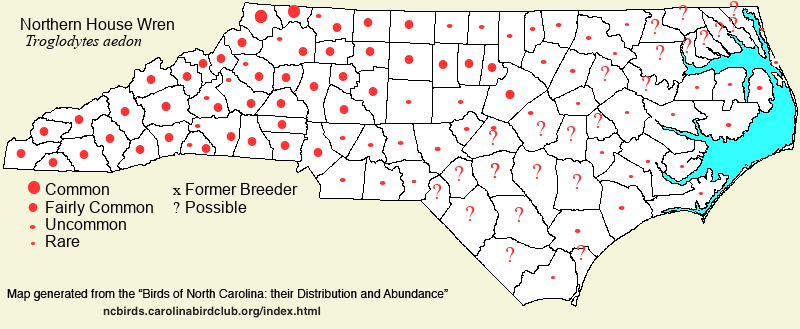 |  |
|
Northern House Wren - Troglodytes aedon TROGLODYTIDAE Members: | Search Common: Search Scientific: |
|
|
||||||
| General Comments |
Northern House Wrens breed from coast to coast across the United States and southern Canada, though they generally avoid the Atlantic and Gulf coastal plains for breeding. They are highly migratory, and birds winter in good numbers in the Coastal Plain, whereas they mainly depart their breeding grounds in the mountains and Piedmont by late fall. This species has undergone a notable breeding range extension in the Southeast; the first nesting in the state's Piedmont was in 1922, and birds spread eastward to the Fall Line by the 1960's or 1970's. A few even nest in recently burned pocosins in the lower Coastal Plain, leaving a gap in the range farther to the west. Breeding habitats are almost always near man, as the birds now use bird houses and gourds almost exclusively for nesting sites. They occur in farmyards, small towns, and partly open residential areas; in many areas of the Piedmont, they occur only in cities and towns as breeders. Migrants and winter residents occur in dense tangles in open or edge habitats -- brush piles, wooded edges, brier patches, weedy fields with some woody vegetation, etc., usually away from man. They can be quite secretive in winter, but their chattering calls give away their location.
NOTE: The AOS (formerly AOU) in 2024 split out a number of species from the former House Wren, including one ranging over most of Latin America and several in the Lesser Antilles. Thus, they added the modifier "Northern" to the name. | |||||
| Breeding Status | Breeder | |||||
| NC BRC List | Definitive | |||||
| State Status | ||||||
| U.S. Status | ||||||
| State Rank | S5B,S5N | |||||
| Global Rank | G5 | |||||
| Coastal Plain | Winter resident, transient, and sparse and local summer resident. As a summer resident, uncommon in towns along the extreme western edge of the region, close to the Piedmont -- such as Enfield, Selma, Fayetteville (regular?), and the Sandhills. Recently has nested or been found on territory in Greenville, Wilson, and Kinston -- well into the central part of the province. Also, rare to uncommon, local, and sporadic (not at consistent sites) at large pocosin areas, generally where recently burned; occurs from the Pamlimarle Peninsula southwest toward Green Swamp (Brunswick). In 2023 and 2024, nesting evidence has been found on the Outer Banks of Currituck and northern Dare. Not known to nest over most of the province. Common but secretive and easily overlooked migrant. In winter, common in coastal areas, fairly common to locally common in the Tidewater zone; fairly common farther inland in the southern half, including the Sandhills; uncommon near the Virginia border. Mainly early Oct to mid-Apr. Peak counts: | |||||
| Piedmont | Summer resident, transient, and winter visitor/resident. Breeds across the entire province, but fairly common only in cities and towns. In the eastern portions, very rare to rare elsewhere (away from cities and towns); farther westward, more often found in farmyards and residential areas away from cities and towns. Fairly common (if not common but secretive) migrant. In winter, uncommon in early winter in the eastern and southern portions, and rare farther west; however, by late winter, few birds probably survive anywhere in the region. Probably best called a rare winter resident along the eastern and southern portions, and absent to very rare elsewhere. Mainly early or mid-Apr into Nov. Peak counts: | |||||
| Mountains | Summer resident, transient, and sparse in winter. Breeds across the region; fairly common over most of the region (and can be common in Ashe), but generally uncommon in the southwestern counties (at least in rural country). Nests up to about 5,500 feet, but two nests at Mount Mitchell State Park (Yancey) in 2013 were at elevations of 6,190 feet and 6,300 feet. Widespread migrant. In winter, rare to uncommon in early winter in low elevation valleys, but essentially gone by late winter. Not considered a winter resident. Mainly mid-Apr to late Oct. Peak counts: | |||||
| Finding Tips |
Normally not hard to find in summer in most residential areas in cities and towns in the mountains and Piedmont. Driving around in the countryside of counties in the northern mountains in summer will produce some birds, also. *** to **** | |||||
| Attribution | LeGrand[2024-11-07], LeGrand[2024-07-19], LeGrand[2023-03-27] | |||||
| NC Map Map depicts all counties with a report (transient or resident) for the species. | Click on county for list of all known species. |
| NC Breeding Season Map Map depicts assumed breeding season abundance for the species. |  |